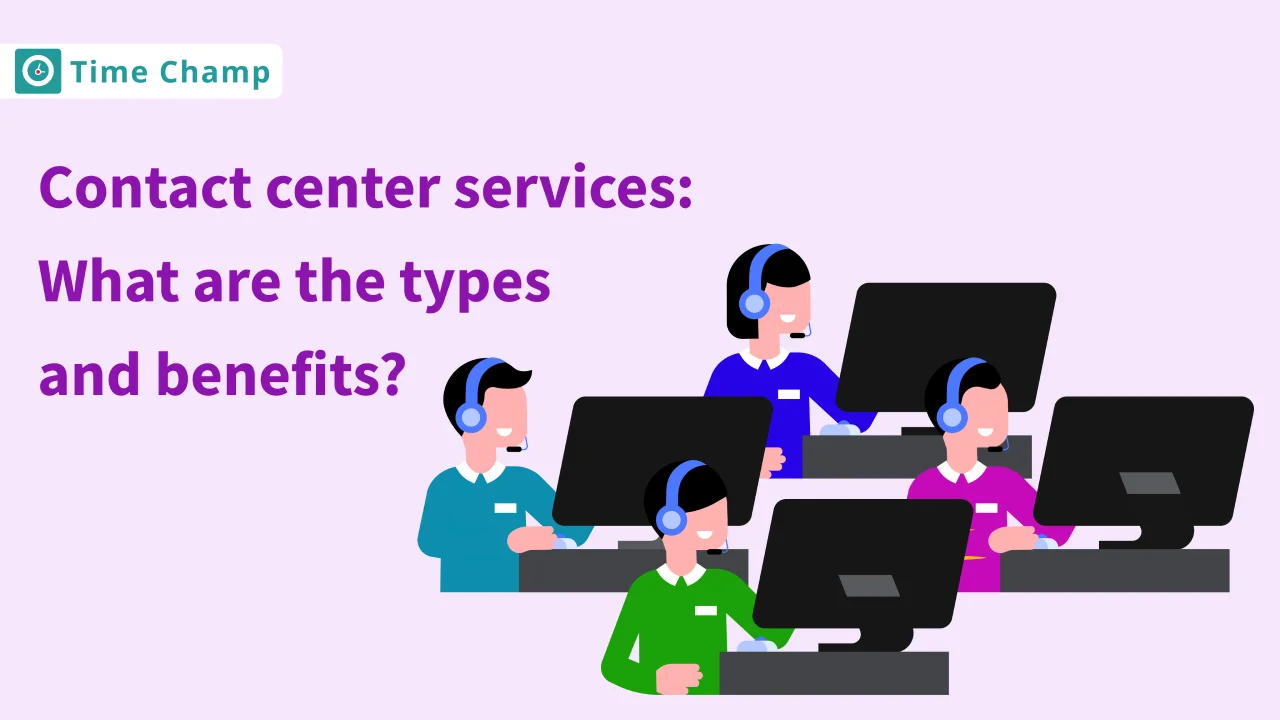Customer service has changed, over time adapting to advancements to effectively meet the needs of customers. One crucial aspect of this evolution is the rise of contact center services, which have revolutionized the customer experience. What exactly are contact center services? How do they differ from call center services? What features do they have? What advantages do they offer?
What are Contact Center Services?
Contact center services encompass means through which businesses can communicate with their customers. Unlike customer service, which was primarily limited to phone based communication, contact center services provide a range of options.
For instance, let’s say a customer encounters an issue with a product they ordered from a store. Of being restricted to making a phone call they now have the option to reach out via email chat, text messaging, social media platforms or even interact with chatbots integrated into the stores’ website. This multi channel approach is what characterizes and sets apart contact center services.
Contact Center Vs. Call Center: How Do They Differ?
Although often used interchangeably there are differences between contact centers and call centers, in terms of scope and functionality.
A call center primarily specializes in managing a volume of phone calls, including both outgoing ones. Its main role involves making sales calls offering customer assistance conducting telemarketing activities and collecting customer data.
For instance, an automobile company could have a call center to contact customers and present car insurance options.
A contact center, on the other hand, employs a multichannel approach encompassing voice calls, emails, text messages, and social media interactions to provide customer support and services. It serves as a central point in an enterprise from which all customer interactions across various channels are managed.
A clothing brand, for instance, might use a contact center to handle customer inquiries via phone calls, respond to queries on their social media platforms, manage email interactions, and respond to comments on their website.
In essence, all call centers can be contact centers, but not all contact centers can be classified as call centers. Whereas call centers are restricted to managing calls, contact centers have expanded their reach to cover other methods of communication, providing a more diverse and efficient customer service approach.
Five Key Features of a Contact Center for Improved Service:
With the growing needs of businesses, contact center services are evolving drastically. Companies, now more than ever, are making use of advanced technologies and various features provided by contact centers to enhance their customer service. Here are the five main features of a contact center that significantly improve service:
1. Contact Database
Contact databases are imperative in the contact center setup. Therefore, this feature ensures that every customer communication is organized for easy reference. This information is stored and easily retrieved by details such as customer name, contact, previous purchase, complaints, and feedback. This improves customer experience and allows agents to know what a customer needs and to provide better and customizable service to each customer.
2. Call Conferencing
The other feature is call conferencing, which allows the agents to talk to various people in a single conversation.
It is especially beneficial in instances where an agent necessitates assistance from a supervisor or another department on behalf of a customer concern. Rapid conference call helps in addressing customer problems in a short time and hence satisfy customers.
3. Call Recording
Call recording, though, is not just for compliance and legal purposes but also for training purposes. The supervisors can use these recordings for quality assurance purposes, new employees’ training, or to examine the most frequent requests and complaints from customers. This means that businesses should be able to know how they appear from the eye of their customers, and make changes to their services or products if need be.
4. Real-Time Reports
Real-time reports in contact centers give real-time reports regarding conversations between a customer and an agent. Such reports are critical to understanding call duration, average wait time, call abandon rates and various other key metrics. Through such information, businesses can adjust their customer service or even seek improvements by making their services more real time.
5. Scripts
In contact centers, scripts are the basis for agents when interacting with customers. This serves as a guide in communicating right from the first greeting to addressing a customer’s problem. They can also be tweaked based on the individual customer’s requirements or past interaction history to deliver a more personalized service.
Each of the five components plays an important role in improving the contact center agent efficiency and quality of services. Businesses need to understand how to make use of these features in their contact centers to enable them to function seamlessly.
Contact Center as a Service (CCaaS): An Advanced Customer Support Solution
The digital world revolves around customer support. This is where Contact Center as a Service (CCaaS) comes into the picture. Essentially, CCaaS is a cloud-based customer care service that enables companies to carry out their customer interactions in a smoother manner. This is why an organization may opt for a CCaaS solution so as to streamline its operations, cut down on expenses, and increase the efficiency of service delivery to customers.
Services offered by CCaaS:
CCaaS offers a variety of services. These include voice calls, emails, social media, live chat support, etc. The ultimate objective is to give business owners the ability to ensure that all their conversations with customers are handled in a single web solution.
A. On-Premise Contact Centers
In an on-site contact center, all the necessary hardware and software are placed within the company. It is an old model, which has been used over and over again. These centers act as the interface between the company and the customers through various channels such as the phone, email, and social media.
Hardware and maintenance costs are also quite high for On-Premise contact centers, and they require a large staff. This means that it also has to keep its servers running and make software updates, face telecommunication issues and the like, but it provides greater control over the customer data, especially for companies handling very sensitive data.
B. Hosted Contact Centers
On the other hand, a hosted contact center is a modern solution introduced by the new cloud technology. The hosted solution differs from its on-premise counterpart because it is availed by a third party service provider remotely through the internet. As such, a company can use a web browser as a contact center platform.
As the contact-center infrastructure runs in the provider’s data centers, this provider takes care of all the technical issues including hardware, software, maintenance and updating. This also helps reduce the expense and enables the business to concentrate on its core operations with an assurance of high-class customer support.
CCaaS is becoming increasingly common among businesses as they shift towards scalability, affordability, and convenient management in today’s digitized world. One of the essential factors to pay attention to as a business is which type of contact center service could be suitable for its current operations and future development.
5 Essential Contact Center Services
A contact center’s suite of services and the tools and channels that it uses to interact with customers form the heart of a contact center. It is therefore important to understand these services so as to be able to deliver a smooth and satisfactory customer experience.
1. Telephone Service
The contact centers still rely on the telephone as their primary communication channel. Many customers still prefer to call when it comes to communicating in the era of digital channels.
A. Inbound Calling
Inbound calling refers to calls received by the contact center. These are often customer inquiries, complaints, or requests. Good contact center needs to take incoming calls in the quickest and most quality way to maintain a positive customer experience.
B. Outbound Calling
On the other hand, outbound calling is where the contact center initiates the calls. They always involve issues related to marketing, customer updates, and follow-up inquiries. Outbound calling should be strategic and respectful – an effective communication channel without being intrusive.
2. Text Messaging Service (SMS)
The advent of mobile devices has seen SMS emerge as an important communication channel for contact centers. This is a convenient method of customer interaction with the contact center to ask questions, update, or just engage with the brand.
3. Chat Service
Chat services go a step further by enabling true real-time digital dialog between the customer and contact center SIM. Chats are conversational, and therefore, tend to provide a more engaging and often effective – alternative to conventional media.
Chatbots
AI-driven communication tools such as chatbots which can simulate human conversation are the most essential and effective ways of handling frequently asked questions by customers. There are two types of chat services:
A. Live chat
The live chat allows users to have real-time human-assisted conversations, which are often important for complex issues that need human input.
B. Automated chat
Chatbots are AI based systems that are programmed to answer the customers’ questions, guide them through the processes or just interact with them as a representative of the brand.
4. Social Media Service
Another important channel for the contact centers is social media. It permits brands to connect with customers in the places where they spend the majority of their virtual time and where they usually like to interact with brands. It also offers the possibility of public, transparent interactions that help to build trust and brand affinity.
5. Email Service
Email remains an effective channel for more formal or extensive communication with customers. It’s often used for detailed responses, updates, newsletters, and marketing campaigns. Feel free to check out the email service provider definition to find out more on this topic. Through email, contact centers can maintain a personal, yet professional, relationship with each customer.
The importance of these essential services can’t be overstated. They make the contact center a multi-channel, customer-focused hub, driving brand loyalty, and success.
5 Key Contact Center Technologies:
Some of the technologies used in contact center operations are very crucial for their interaction with customers. Let’s take a look at five key contact center technologies:
1. Predictive Dialer
A predictive dialer is a web-based outbound calling system, which automatically calls from the list of telephone numbers. Once a person has answered it gets connected to the call agents immediately. This eliminates the need for agents to manually dial numbers and wait for a response, making the calling process more efficient.
2. Automatic Call Distributor (ACD) System
In general, an automatic call distributor (ACD) system is commonly regarded as being the backbone of a contact center and it serves by managing the inbound calls and rerouting them to the appropriate agents using predetermined criteria such as the caller’s IVR menu selection, the caller’s telephone number, time of day, and the available agents.
3. Email Response Management System
Contact centers use an email response management system to ensure proper handling of high volumes of inbound emails. Automated with defined rules, it prioritizes and routes emails, making sure that urgent emails are addressed first, while all emails get timely and correct replies. Email is increasingly important in today’s digital age for customer service operations.
4. Knowledge Management System
The knowledge management system is a tool that centralizes and categorizes company and product information in a single repository, making it easy for agents to look up a response to a client’s query. This not only increases efficiency but also make sure that customer can get the exact information through all service channels.
5. Workforce Management Software
Workforce management software helps contact center managers to forecast call volumes, schedule agents, measure agent performance, and adapt resources accordingly. It further assists in providing actionable intelligence that can be used for operational improvements.
These advanced technologies when integrated into a contact center can indeed enhance operational efficiency leading to better customer experience and boosting the call center’s productivity.
Your Agents Are Your Most Important Assets
Without a doubt, your most valuable resources in a contact center are your agents. The effectiveness and productivity of their work hours can heavily influence the success of your contact center services. However, a common issue among such work environments is the risk of burnout due to factors like high work volume, demanding performance targets, and lack of adequate rest.
Fortunately, tools like Time Champ can greatly help you navigate these challenges.
How Can Time Champ Help?
Improve your contact center’s performance and productivity with Time Champ, the premier time and productivity tracking software. Time Champ’s cutting-edge features seamlessly manage work hours and tasks, boosting performance without overwhelming agents.
By precisely monitoring the hours worked, tasks completed, and breaks taken, you gain valuable insight into each agent’s workload and productivity levels. This valuable information allows for effective workload management, minimizing burnout and increasing overall agent satisfaction. Additionally, the comprehensive data gathered by Time Champ can reveal performance trends, identify areas in need of improvement, and inform smart strategies for boosting productivity even further.
Conclusion
As the landscape of contact centers continues to evolve, it is vital to adopt the proper strategies, technologies, and resources to consistently provide exceptional customer service and meet organizational goals. It is evident that contact center services hold a significant influence on a business, impacting customer satisfaction, agent productivity, and overall business intelligence.
By equipping your contact center with essential services such as telephone, chat, and social media support, and utilizing key technologies like Time Champ, you can revolutionize your contact center operations. This will enable you to stay ahead of the curve and consistently provide top-notch service, ultimately leading to customer loyalty and improved business insights.
Why not give Time Champ a try? Improve your contact center’s efficiency, enhance your agents’ productivity, and take the success of your business to new heights. Click here to try Time Champ today!
FAQs
A contact center is a hub for managing all forms of customer interactions, including inbound and outgoing phone calls, SMS text messaging, web chats, emails, and social media conversations. It’s a comprehensive solution to handle and keep track of customer communication across different channels, ensuring seamless support and enhancing the customer’s journey.
A call center is a centralized department used for receiving or transmitting a large volume of requests by telephone, they mainly focus on telephone conversations.
Distinguishing Contact Centers from Call Centers (ContactCenter Vs. Call Center):
Although often used interchangeably there are differences between contact centers and call centers, in terms of scope and functionality.A call center primarily specializes in managing a volume of phone calls, including both outgoing ones. Its main role involves making sales calls offering customer assistance conducting telemarketing activities and collecting customer data.
A contact center, on the other hand, employs a multichannel approach encompassing voice calls, emails, text messages, and social media interactions to provide customer support and services. It serves as a central point in an enterprise from which all customer interactions across various channels are managed.
In essence, all call centers can be contact centers, but not all contact centers can be classified as call centers.
Some essential services include telephone service for inbound and outbound calling, text messaging service (SMS), chat service, social media service, and email service.
On-premise contact centers are located in-house, requiring companies to maintain their own IT infrastructure and support. Hosted contact centers, on the other hand, are managed by a third-party provider, taking away most of the heavy lifting in terms of maintenance and IT support from the company.
Some key technologies include predictive dialers, Automatic Call Distributor (ACD) systems, email response management systems, knowledge management systems and workforce management software.
CCaaS is a cloud-based customer experience solution that allows companies to utilize a contact center provider’s software. CCaaS providers maintain and develop the necessary hardware and software for the center. Companies can scale services up and down depending on their needs.
Some key benefits of using contact center services include better customer experience, improved agent efficiency, and enhanced business insights.
Champ is a productivity tracker software that helps monitor and improve employee productivity. It provides real-time insights into work habits, helping to identify areas of improvement, prevent burnout, and ensure agents stay productive during work hours.







